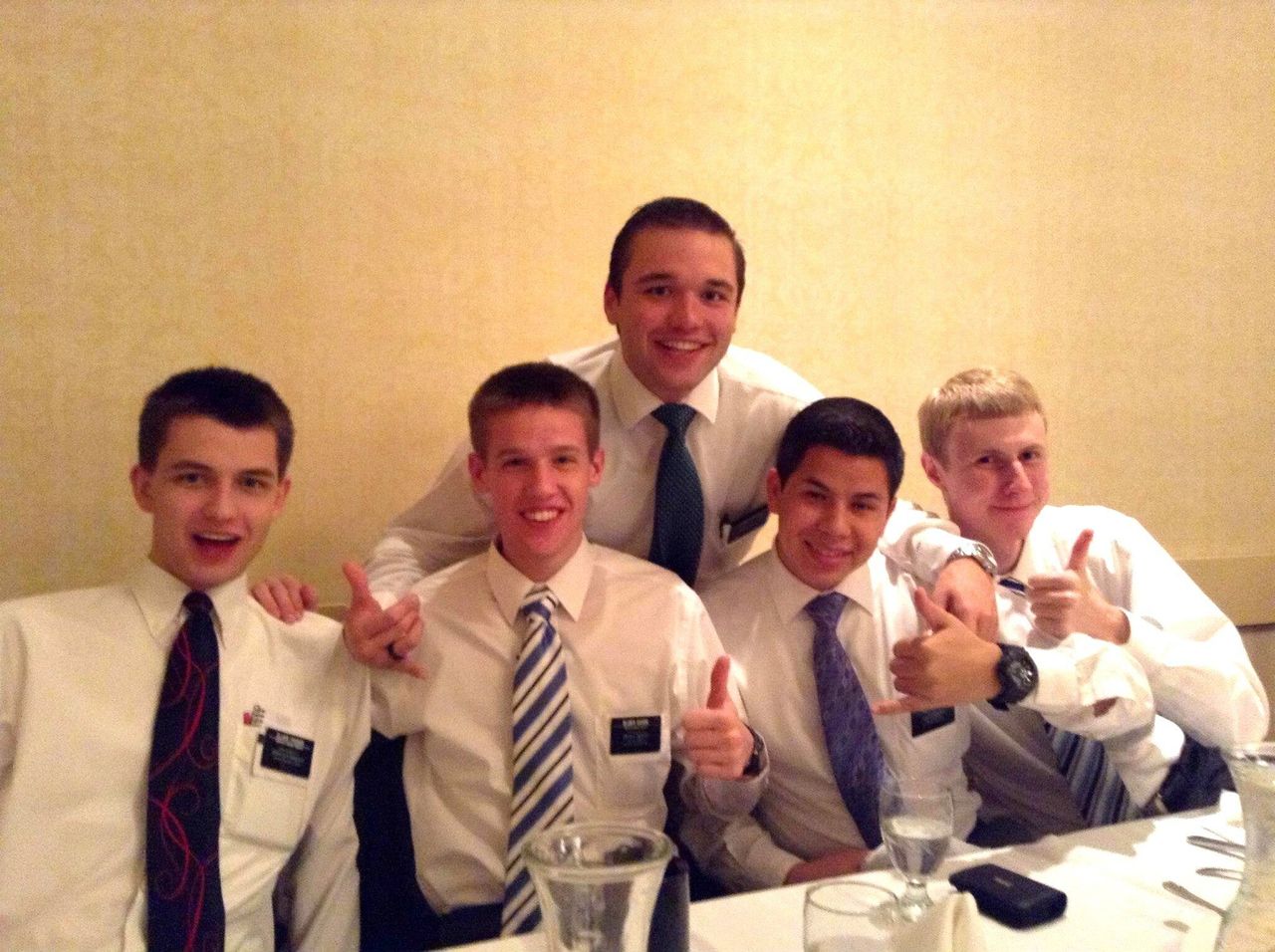Until three years ago, Aubert L’Espérance had no idea who Mormons were or what they believed. All he knew was that he liked messing with them.
To be fair, L’Espérance, then 15, was clueless about most religions. The preppy-chic Québécois had never been to church, grew up agnostic verging on atheist and assumed “Mormon” was just another name for the Amish when he first stumbled on the Church of Jesus Christ of Latter-day Saints online. He’d been browsing his favorite timewaster -- the Art of Trolling, a website less holy, more holy shit. And there, between funny snapshots of misspelled signs, he discovered a new religion and an addictive pastime: pranking the missionaries manning the official “Chat with a Mormon” homepage.
Hoping to attract converts, the church invites people to come online and message anonymously with missionaries who can answer “whatever questions you may have about any Christian topic.” L’Espérance, like thousands of other Internet trolls, abused it spectacularly, logging on with a fake persona and bombarding the Mormons for hours with nonsense questions.
But then, L’Espérance’s hoaxing gave way to something that surprised even him: a genuine curiosity in a group he says he’d assumed was “just some sort of tribe” living in “really remote parts of the universe.” Less than a year after first fooling around with Mormon missionaries, L’Espérance was baptized. Ryan Tucker, a missionary who helped convert him in the church’s chatroom, hailed it as a journey “from troll to testimony.”
"Those chats were so amazing," says L'Espérance. "Before I even knew much about the church, I really felt its power immediately."
The teenager’s unlikely route to baptism helps explain why the white-haired patriarchs of the Mormon church stunned their followers last summer by lifting a ban barring missionaries from social media.
During a worldwide broadcast in June, the church leaders heralded a new era of redemption through screens. All 84,000 of the church’s missionaries would eventually be able to proselytize over the web using a previously forbidden arsenal of media, including blogs, email, text messages, Skype and even Facebook. Along with their in-person preaching, missionaries can now use social networks to check in on potential converts, or woo new ones with status updates about the Heavenly Father.
“The principles missionaries have always been taught actually just work better online,” says Gideon Burton, a professor at Brigham Young University who has advised the church on its Internet missionary work. “It’s going to be a lot more efficient.”
For Mormons, this about-face on social media was a radical change, as startling as if the church had dropped its ban on beer. Until the June announcement, the Internet had been off-limits to missionaries to shield them from “worldly entertainment,” like the Times and Twitter, that could distract them from their religious calling. The missionaries, who can serve from age 18, could go online just once a week, and then only to blog about their faith or email their family. Phone calls home were permitted just twice a year.
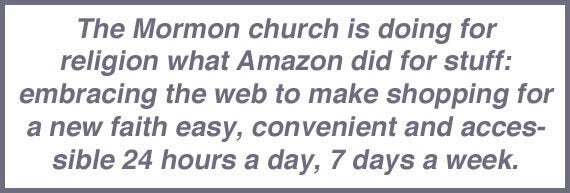
The same tools recently eschewed as slippery slopes to temptation have now been sanctioned by the church to convey the most sacred of messages and fulfill one of the holiest of Mormon duties.
In what marks a new phase in the evolution of one of the fastest-growing religions in the world, which has doubled in size since the 90s, the Mormon church is doing for religion what Amazon did for stuff: embracing the web to make shopping for a new faith easy, convenient and accessible 24 hours a day, seven days a week. Despite its conservative reputation, the church has actually been an early adopter of any tech that might deliver baptisms. Just as it did nearly 200 years ago, when the church pioneered mass-market distribution of its Bibles by printing a half-million texts, and a century ago, when it released a feature film on the Book of Mormon, now it is pinning its hopes on the marketing muscle of a technology with even broader reach: the web.
In an age of Internet-enabled instant gratification, the church is betting the demand for instant salvation can’t be far behind.
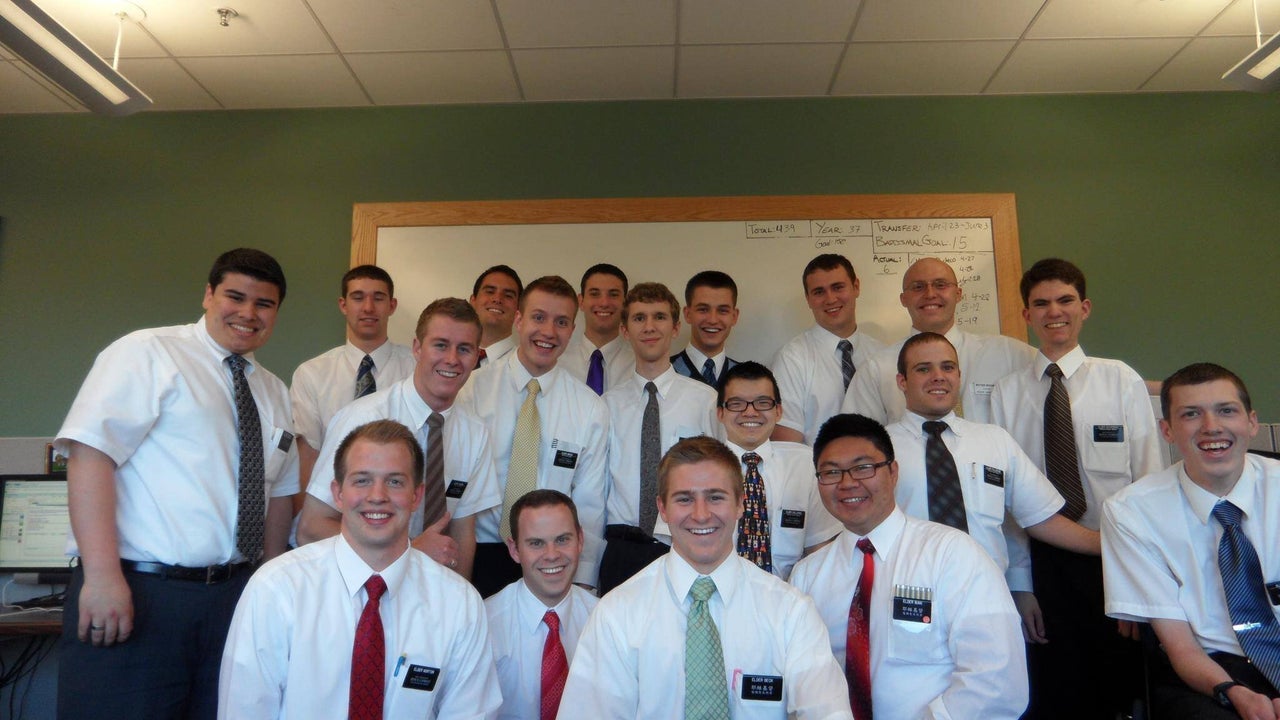
The shift on social media actually began over five years ago, in 2008, with a quiet experiment at the Referral Center Mission in Provo, Utah. The first online-only mission -- and the official headquarters of “Chat with a Mormon” -- launched as a call center-type operation set up to answer basic questions about the church and accommodate injured or disabled missionaries who’d have difficulty marching through neighborhoods. Believing that accepting a new faith would be far too profound a revelation for mere chatrooms, the church instructed the inaugural Internet missionary to funnel potential converts to local missions, which could take over offline.
Wrong move, they discovered. People like L’Espérance preferred the safety of a screenname to the awkwardness of lectures from two strangers in suits.
Even within a church legendary for adding converts with machine-like efficiency, the Internet-only mission has been an outlier. Whereas traditional Mormon missionaries convert, on average, six people during their 18- to 24-month service, the online apostles in Provo have averaged around 30 converts per missionary per year, says Burton. And these people stick around. Ninety-five percent of the Internet converts have kept active, a retention rate more than triple the norm.
“It’s unheard of,” says Burton. “[The Referral Center Mission] was equal to the highest-baptizing missions that are out there.”
Damning influences be damned: Church leaders realized these so-called “Facebook missionaries” were getting results too impressive to ignore.
Tracting, or sending missionaries house to house, has since the 1830s been a pillar of the church’s expansion that helped it grow to over 15 million members. In the past few decades, however, the number of converts has shown a concerning drop, from a peak of 331,000 a year in 1990 to just a little over 272,000 in 2012, according to official church records. Sometime between the car phone and the iPhone 5, people stopped opening their doors to the itinerant pairs of neatly dressed proselytizers. Plunging missionaries into the very epicenter of worldly entertainment looks like the best shot at fixing a problem that otherwise may only grow worse.

“Now, many people are involved in the busyness of their lives. They hurry here and there, and they are often less willing to allow complete strangers to enter their homes, uninvited, to share a message of the restored gospel,” lamented Elder L. Tom Perry, a 91-year-old member of the church’s top leadership body, when he introduced the digital strategy. “Their main point of contact with others, even with close friends, is often via the Internet. The very nature of missionary work, therefore, must change if the Lord is to accomplish His work.”
This e-proselytizing not only marks a change in the machinery of the church, but also suggests a rewiring of our own instincts. As the Mormon church has learned in the course of its experiment, we’d rather discuss life’s most intimate topics through the impersonal anonymity of the screen.
“[W]e could knock on their door and they’d never let us in,” says Emilee Cluff, a missionary who served between 2011 and 2012, of her efforts to proselytize. “But they’d accept our friend request on Facebook all the time.”
Members of the Mormon church believe they’ve been blessed with the “gift of tongues,” an uncanny talent for languages that allows them to preach the Gospel anywhere, to anyone. Tucker, a square-jawed 21-year-old from Syracuse, Utah, will tell you he used this gift to be a more effective missionary. Only, in his case, his “tongue” was the language of email, texting and instant messaging.
Between June 2011 and July 2013, Tucker served at the Referral Center Mission, joining the ranks of dozens of other college-age men who’ve been tapped for the church’s online-only service. He received little initial training -- "they just turned the missionaries loose,” says Burton -- and Tucker had to continually improvise a strategy for making himself and his faith seem friendly through the sometimes sterile medium of typed messages.

The youngest of six children in a devout Mormon household, Tucker, who has muscular dystrophy, had been looking forward to his mission for as long as he could remember. And yet when he received his call to serve in Provo, he was devastated. The church’s forays into online evangelism were then still largely unknown beyond the innermost circle of the church elite. From what Tucker could glean, he figured he would be put to work filling orders for copies of the Book of Mormon.
But after the mandatory two weeks of missionary training, Tucker realized he’d be counseling more people each day than most missionaries meet in a week, chatting privately online with potential converts as far off as Albania and Ghana for 11 hours a day, six days at a stretch. Tucker would set up Skype- or Facebook-based appointments to tutor prospects in the key principles of his faith. (The church requires these “investigators,” as they are known, to be taught four lessons covering such topics as “the plan of salvation” before they can be baptized.) Most of the time, however, he was juggling two, three or even five chats at a time with anyone who signed on to “Chat with a Mormon.” He’d answer questions about polygamy, take abuse from argumentative atheists and tell people about going to church.
“At the end of most days,” he says, “the number one feeling was exhaustion.”
In the lulls between chats, Tucker used his Facebook profile and personal blog to post digital breadcrumbs like Bible verses or church videos that might lead people his way. (“How did you see the Lord's hand in your life recently? This is a legitimate question -- I want answers!”) The church discourages online tracting -- approaching people at random with messages about the Gospel -- so while Tucker’s friends were trudging through neighborhoods searching for sympathetic ears, the missionaries in Provo just had to sit back and wait for people to come to them.
Which they did, in droves.
Of the thousand-odd strangers who log on to “Chat with a Mormon” each day, slightly more than half have a genuine interest in learning more about the religion, according to missionaries who have served in Provo. This leads to more baptizing with less effort: Missionaries can now put their legwork aside and focus on reeling in a self-selected cohort curious enough to reach out directly. What’s more, the Facebook missionaries also get an all-access pass into neighborhoods their traditional counterparts have struggled to touch.
“This kind of reversed the entire arrangement with how missionaries work: Rather than us knocking on peoples' doors, they were knocking on our door,” says Burton. “People are much more reachable who would otherwise be out of reach -- people in gated communities, remote areas or areas of the world where the church is not allowed to proselytize. We’ve had converts in Asia and other places where the church is not formally recognized, but where people have found the church online.”
“Chat with a Mormon” asks only for a first name, and the anonymity has emboldened people of all ages to sign on for reasons both spiritual and sacrilegious. Chatters come to find, mock, scold, convert, question and berate the missionaries, as well as to confess sins, air doubts and seek advice. A missionary who served in Provo recalls messaging with people so lonely, they sat through weeks of the missionaries’ lessons, only to return, under a different name, hoping to be taught again "because it gave them someone who cared about them." Even though the pseudonyms attract Bart Simpson-esque trolls, they also bring people who can indulge a vague interest in the church without the headache or embarrassment of inviting gangly teenagers into their living rooms. The online missionaries have also tapped into a hidden constituency: members of the church who experience crises of faith that they’re too ashamed of taking up with their fellow believers.
"I think one of the best things about the chat is the anonymity a person has," says Tyson Boardman, the first-ever Internet missionary. "They're able to be completely open with us about any questions they might have reservations asking a person at church. Because of that, we were able to get down to a lot of people's primary concerns."
A survey of people converted by the Internet evangelists found that 60 percent "preferred having online discussions during the conversion process," according a 2010 story in LDS Living magazine. One college-age convert used "Chat with a Mormon" to ask questions anonymously and ensure her Mormon friends weren’t twisting their answers to tell her what they thought she wanted to hear. Michael Johnston, a 20-year-old from Oklahoma who was baptized in 2010 after chatting with Referral Center missionaries, liked the safety of knowing he could quickly exit the chat any time he got uncomfortable.
“On the Internet, if something were to happen, I could just blame it on an Internet error or say, 'Oh, my computer crashed.' I didn’t necessarily have to fully commit to talking with them,” says Johnston. “If I hadn’t had Mormon.org, I don’t feel like I would even be a member of the church.”
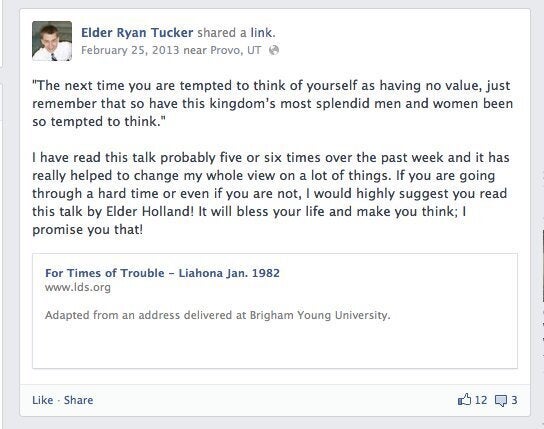
From 11 a.m. through 10 p.m., Tucker worked side-by-side with five to 30 other young men in a utilitarian room with the industrial carpeting, low ceilings, fluorescent lights and gray cubicles of a car dealership. (Female missionaries also field chats in Provo, though none serve full-time there.)
Tucker and his partner took each chat together as a pair, and would monitor each other’s screens for any illicit tweeting or Poking. Slip-ups do happen, even among the saintly. A “sister” who served in a California mission -- one of a handful that tested the combination of traditional tracting and online follow-ups that will soon be standard -- says a few young men were caught using Facebook to flirt with girls they’d met on their neighborhood rounds. It’s known as the “flirt to convert,” and, though the peccadillo pre-dates social media, it’ll get missionaries kicked off their Facebook accounts.
Since the online missionaries operate a click away from sin at all times, Tucker and his fellow proselytizers had to put up with extra chaperoning by Referral Center Mission staffers who reviewed each message going in and out of the Provo office.
This was “a point of frustration for us because we always felt like we were watched,” says Tucker. He remembers being chastised for sympathizing with a skeptic to whom Tucker had admitted he had personally struggled with the same point of dogma before coming to accept it.
“One of the leaders came back and said, ‘I don’t think it’s good to say you’ve questioned a point of doctrine,’” Tucker says. “I personally think it makes us more reliable to say we’re not just uncritically accepting this, and that we are thinking through this.”
“Chat with a Mormon” missionaries don’t stick to a set script, but do quickly steer conversations toward the virtues of their faith. A pair of proselytizers will begin with low-pressure banter -- they introduce themselves, ask the visitor if she has a question -- then try to use her query to initiate a chat about her beliefs. "My companion is typing up a response," a missionary might say. "But while you wait, why don't you tell me what brought you to Mormon.org?" As they go, they’ll test chatters’ sincerity and try to weed out the trolls by giving “micro-commitments,” such as an article to read. If someone can’t be bothered to click the link, the missionaries assume she isn’t serious and politely wrap up the chat.
Tucker also obsessively analyzed the snippets of text onscreen for clues about each visitor’s receptivity to the Word. He says with help from his "gift of tongues," he could tell if something was amiss just by a subtle switch in punctuation -- from exclamation marks to ellipses -- or by the length of time it took for a chatted reply. He and other missionaries found smiley face emoticons, paired with references to “peace,” “comfort” and “enlightenment,” were good hints their pupils had been moved by the Holy Spirit, meaning they believed the teachings about the Gospel to be true.
“It became fairly easy to recognize people who were less than serious. The hard part was not treating them as such,” says Tucker. “The second we say, ‘This person’s a troll,’ is the second that we give up on helping them.”
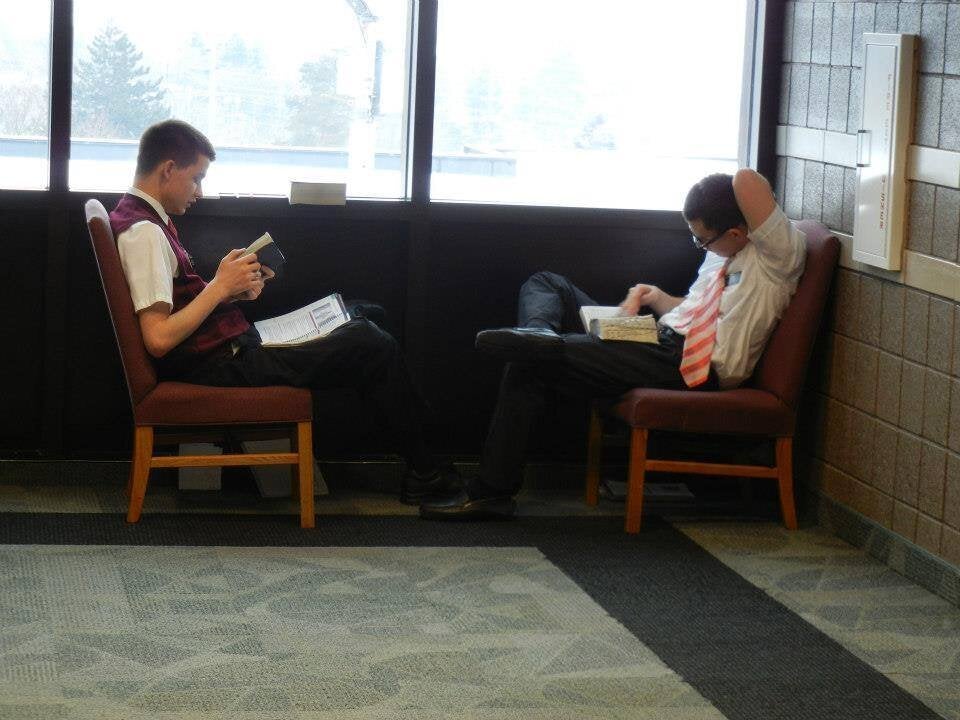
This person’s a troll, Tucker figured when he first spoke with L’Espérance.
It was the fall of 2011 when L’Espérance, then 16, logged on to “Chat with a Mormon” and, by chance, was paired with Tucker in a chatroom. It was eight months after the peak of L’Espérance’s trolling, and L’Espérance confessed to Tucker that he’d messed around with the missionaries before. Still, he insisted he was back now to learn about their faith. For real.
L’Espérance’s older brother was then recovering from a near-fatal car crash, and L’Espérance, who’d replaced pranks with prayers in the wake of the accident, had sworn to no particular god or faith that he would join a church if his brother pulled through. Now he felt he owed it to the missionaries to at least hear them out after all the hours he’d harassed them.
Tucker, not entirely convinced, shrugged off L’Espérance with a vague suggestion to read the Book of Mormon. To Tucker’s surprise, L’Espérance actually did. The next time the Canadian returned to Mormon.org, the two scheduled a time for L’Espérance’s first lesson on Skype. Each chat session opened with a prayer, then Tucker and his companion would guide L'Espérance through the tenets of his faith using church websites, online Prezi slideshows and short, church-approved YouTube videos. Tucker might dive into the intricacies of church history or explain the Mormon take on "the character of God." Every part of the conversion process -- save attending church and entering the baptismal waters -- could elapse over instant messaging.
L’Espérance saw immediate benefits to confining any and all conversion talk to his computer. For one thing, he didn’t have to involve his parents, agnostics who looked askance at religion. After L’Espérance ordered a copy of the Book of Mormon, he discovered with some dismay that it came with a pair of missionaries who showed up at his doorstep one evening.
L’Espérance refused to invite them in, worrying it would disturb his family. So instead, the shivering missionaries spent 30 minutes huddled with L’Espérance on the porch of his house, narrating the life of Joseph Smith Jr. in the chill of the November night.
“If you could possibly imagine the worst circumstances for a missionary lesson, those would be the circumstances,” recalls L’Espérance.
Yet on the Internet, Tucker was never an inconvenience. L’Espérance could message the missionary any time he saw Tucker’s screenname pop up on Skype and the two would have daily, informal chats, even between their official lessons, undisturbed by disapproving parents, intrusive siblings or the need for formality. Missionaries in turn see such talks as a chance to forge stronger bonds with their acolytes and prove Mormons aren't “robots” -- a concern expressed by more than a few missionaries.
“We understood our job was to teach him, yeah, but also to be his friend and help him,” says Tucker.
A Prezi presentation Tucker shared with potential converts online.
With missionaries in the U.K., Mexico and New Zealand now helping man the "Chat with a Mormon" service, anyone can instantly reach a missionary whenever the urge strikes, and in a two-dimensional format many already know and love. The church can even take advantage of people's "rabbit hole" indulgence online -- a tendency to get lost in an endless progression of sites and Google searches that crop up when someone explores a random topic that catches their fancy. Liza Morong, for example, went online one evening after seeing the irreverent "Book of Mormon" musical. The 21-year-old visited Mormon.org, purely to "see just how insane they were," she wrote later. She impulsively signed on to “Chat with a Mormon” to "destroy everything those missionaries were 'told' to believe," but ended up sending a Facebook friend request to the missionary she talked to, then casually messaging about his faith. Three months later, Morong was baptized.
Even after L’Espérance received his parents’ blessing to invite the two missionaries into their home, he still saved the more delicate topics about the Mormon church for Skype. He especially welcomed the privacy of the screen when it came to one of the church’s most challenging commandments, and one nearest to the hearts of 16-year-old boys: the law of chastity, which forbids masturbation, sex before marriage and same-sex intercourse.
“To be very blunt: You don’t really want to discuss things like masturbation with people you don’t know, in person,” says L’Espérance. “It’s a little bit hard looking someone in the eyes and telling them you have problems living the commandments with regard to chastity. And in another regard, it’s a little bit tough talking about those things out loud when your family is around.”
“It was easier online because you don't need to actually speak certain things,” L’Espérance adds. “It’s more of an impersonal thing when you're online.”
More impersonal, but more honest. The two missionaries who’d been teaching L’Espérance offline were the first to learn that he’d decided to convert. But L’Espérance turned to Tucker for help with the full-on crisis that followed L’Espérance’s baptism that December. “Overwhelmed with horrible feelings” about his decision to convert, L’Espérance debated expunging his name from church records just moments after taking his vow. He rushed home, where he says he “cried my life out,” masturbated and refused to speak to anyone.
"I felt like I needed to reject everything that I’d received," he says.
In an earlier age, L’Espérance might never have addressed his doubts and slowly faded away from the church, like the 70 percent of all converts who fail to stay active after their baptisms. Instead, L'Espérance logged on to Skype to share his breakdown with Tucker, who said he was sorry and told L’Espérance to pray. The new convert followed Tucker’s advice. He says he later felt “an overwhelming sense of peace” about his decision.

Today, L’Espérance’s entire Facebook persona seems to have become a tribute to his faith. The church actively encourages its members to engage in their own, informal Internet missionary work by using social media to talk about their beliefs to their friends.
"Your fingers have been trained to text and tweet to accelerate and advance the work of the Lord -- not just to communicate quickly with your friends,” David A. Bednar, a member of the church's second-highest governing body, said in 2011. “The skills and aptitude evident among many young people today are a preparation to contribute to the work of salvation.”
On Facebook, a beaming photo of L’Espérance -- Book of Mormon in hand -- sits over a string of posts about “God’s power” and “brethren in testimony.” His online nickname is “AubertBelieves.” And this spring, L’Espérance will be fulfilling his God-given responsibility to spread the Word as he sets out on his own mission.

In July of last year, as Tucker’s mission was coming to an end, L’Espérance decided to fly from Quebec to Salt Lake City to surprise Tucker on the very first day he came home from his service. The two had never met in person, but it seemed to L’Espérance that a deep bond had grown over the months they’d spent messaging about intimate topics and his deepest doubts. Tucker had learned the most personal things about L’Espérance, and had guided him to the most important decision in L’Espérance’s life. If they could be so close over the Internet, imagine the kindred spirits they’d be when they finally met in real life.
After his 8 1/2-hour flight from Canada and two nights in Salt Lake, L’Espérance went to the church where he knew Tucker would be speaking at a Sacrament meeting. L’Espérance went up to introduce himself as soon as Tucker finished his talk. The reunion wasn’t quite what L’Espérance had hoped for.
“I expected him to react more strongly, but it was like, ‘Oh, it’s cool you’re here,’” L’Espérance says, laughing dismissively. “Obviously he was excited about coming home, but I don’t think he understood everything that my presence implied -- my coming over, and all the planning and the scheduling. That’s cool, you know. That’s not his approach.”
Real life may have brought them face-to-face, but in that moment it lacked the intimacy of the Internet, with its seamless harmony and easy honesty. The gathering of people paled next to the merging of pixels.
